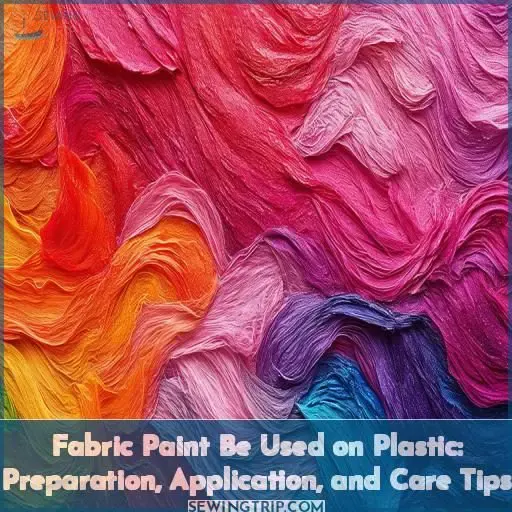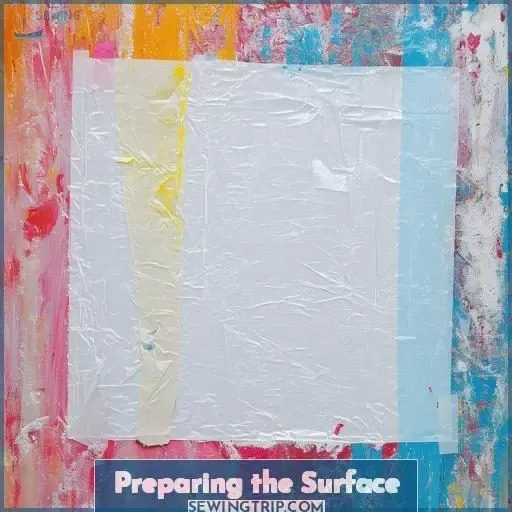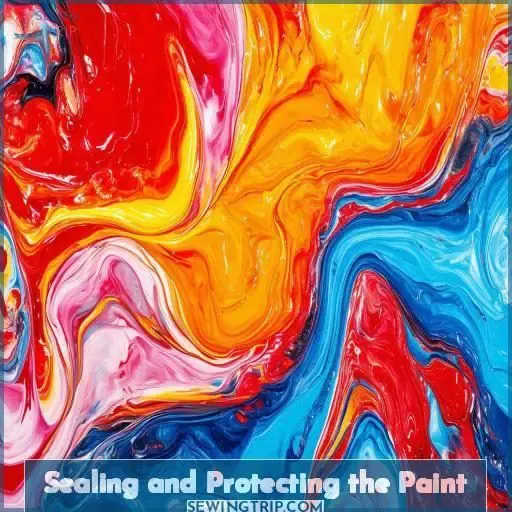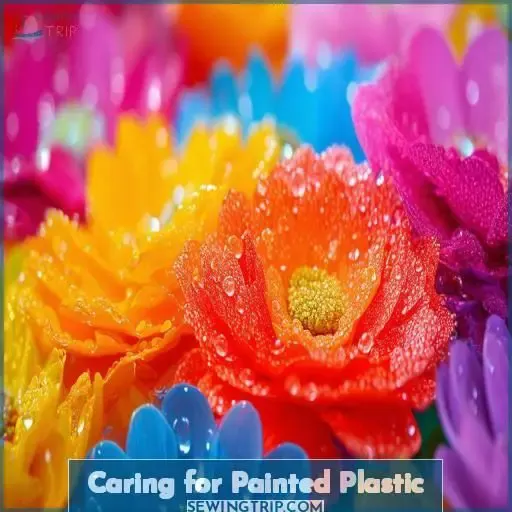This site is supported by our readers. We may earn a commission, at no cost to you, if you purchase through links.
 Fabric paint can absolutely be used on plastic surfaces. Just prep the plastic first by cleaning and lightly sanding it.
Fabric paint can absolutely be used on plastic surfaces. Just prep the plastic first by cleaning and lightly sanding it.
Then, grab some fabric paint formulated for adhesion—soft body acrylics thinned with fabric medium work wonders.
Apply in thin layers, allowing proper drying time between coats.
Once fully covered, seal it all in with a clear acrylic sealer or varnish.
With the right techniques, your painted plastic will stay vibrant and durable.
Ready to embark on a new adventure of revitalizing those old plastic pieces? Let’s delve into the specifics on making fabric paint stick.
Table Of Contents
Key Takeaways
- Don’t be alarmed, fabric paint and plastic can be a match made in heaven! With a little TLC, you can transform drab plastics into vibrant, personalized works of art.
- Proper prep work sets the stage for success. A spritz of elbow grease (cleaning, sanding lightly) goes a long way in ensuring that brilliant fabric pigments adhere like a champ.
- Finding the right paint is key – soft body acrylics or ones specially formulated for plastics are the star players here. Mix them with a fabric medium and voilà! They’ll stick like glue.
- Seal the deal by guarding your creation with a clear acrylic sealant or varnish. Consider it armor against fading, chipping, and the general wear and tear of life’s adventures.
Preparing the Surface
Preparing the surface is the first critical step to guarantee your fabric paint adheres perfectly to plastic.
Start by wiping away any dust with a clean cloth. This removes debris that could prevent proper adhesion.
Next, lightly sand the plastic surface to create a bit of texture; this aids in fabric paint sticking better. Use fine-grit sandpaper for this task.
After sanding, clean the surface again with a damp cloth to remove any sanding residue. Let it dry completely before moving on to painting.
Choose a compatible primer specifically designed for plastic to enhance adhesion further. Apply the primer in even, thin coats and allow it to dry thoroughly, ensuring a solid foundation for your textile painting venture.
Choosing the Right Paint
When choosing paint for plastic, you need to assess its compatibility and how well it adheres to the surface (Source). Proper techniques guarantee long-lasting durability, guaranteeing your painted plastic items stay vibrant and intact (Source).
Compatibility with Plastic
When choosing fabric paint for plastic surfaces, consider paint compatibility and long-term durability.
Soft body acrylics mixed with fabric medium offer flexibility and better adhesion.
Verify the paint’s compatibility with plastic surface adhesion by preparing the substrate properly.
Opt for paints that include finishing techniques for enhanced durability and maintain vibrant colors using suitable fabric painting techniques such as airbrush application.
Proper Adhesion Techniques
To guarantee fabric paint adheres well to plastic, surface preparation is essential. Begin by cleaning the surface with a mild detergent, followed by sanding to create a rough texture.
- Apply a suitable primer for enhanced adhesion.
- Use adhesion enhancers specifically for plastic.
- Choose either spray or brush techniques for application.
- Consider opting for acrylic paint for flexibility.
- Integrate fabric stamping or stenciling methods.
Durability and Longevity
For long-lasting paint on plastic, begin with proper surface preparation. Choose compatible paints specifically marked for use on plastic and apply thorough adhesion techniques. Use clear coat sealants for added protection. Silk-screen printing and watercolor effects can enhance designs, provided you follow recommended care tips like gentle cleaning and avoiding excessive friction (Source).
Applying the Paint
You’ve chosen the right paint for your plastic surface, now it’s time to apply it.
Select brushes suitable for the level of detail needed, like angled brushes for clean lines or softer brushes for blending.
Thin the paint if necessary, following the manufacturer’s guidelines, for a smooth application.
Layer colors gradually, allowing proper drying times between coats.
Experiment with color mixing directly on the surface for unique shades.
Pay close attention to brush strokes and paint consistency to achieve your desired finish.
With care and patience, you’ll transform that plastic object into a vibrant, personalized creation.
Sealing and Protecting the Paint
After applying your fabric paint to plastic, sealing and protecting it’s essential for longevity. Allow ample drying time, as the thickness of paint layers affects cure duration. Once fully dry, consider these options:
- Apply a clear acrylic sealer for added protection and a glossy finish.
- Use a matte varnish or fixative for a satin sheen.
- Lightly sand and topcoat with a UV-resistant clear coat for outdoor pieces.
- For extra durability, apply multiple thin sealer coats, lightly sanding between layers.
No matter which route you choose, proper sealing guards against chips, scratches, and fading from sunlight exposure. With the right protective topcoat, your vibrant fabric-painted plastic pieces will maintain their brilliance for years.
Caring for Painted Plastic
You’ve put in the effort to paint your plastic surfaces, now it’s time to care for them properly.
Be gentle when cleaning – avoid abrasive sponges or harsh chemicals that could scratch or damage the paint. Mild soap and water should do the trick.
If you need to remove paint, try a plastic-safe solvent or carefully peel it off.
Proper surface prep is key for longevity – lightly sand, then clean with degreaser before painting. Adding a fabric medium to your paint can improve flexibility too.
And use soft brushes to avoid brush strokes showing through.
With some TLC, your painted plastic pieces will look vibrant for years to come.
Suitable Plastic Surfaces
You can express your creativity on various plastic surfaces like bottles, containers, jewelry, and home decor items using fabric paints. These versatile paints adhere well to plastics, allowing you to personalize and transform ordinary objects into vibrant, stylish pieces.
Plastic Bottles and Containers
You can easily transform plastic bottles and containers with fabric paint. For smooth surfaces, apply paint using a brush or freehand painting. Stenciling and spray application allow you to create intricate designs. Consider the container’s shape and size when choosing a technique – freehand works well for larger areas, while stenciling excels for precise patterns.
Plastic Jewelry and Accessories
When painting plastic jewelry and accessories, thorough surface prep is key. Follow these steps:
- Clean and lightly sand the surface for better adhesion
- Use primer or plastic-compatible paint for lasting color
- Apply paint in thin, even coats, allowing proper drying between layers
- Seal your design with a clear acrylic sealer after painting
With the right preparation and materials, you can transform plain plastic pieces into vibrant, personalized accessories.
Plastic Home Decor Items
Plastic home decor items like vases, frames, and planters are perfect for fabric painting! Prepare the surface properly, then use compatible acrylic paints. Apply base coats for brightness, and seal with a clear acrylic finish. Care for painted plastic by avoiding abrasion and extreme temperatures. With the right preparation, paint selection, and application techniques, you’ll create durable, vibrant decor pieces.
Techniques to Try
You can release your creativity on plastic surfaces by using fabric paint and stencils to create intricate patterns or designs. Rubber stamps and sponges also offer a fun and easy way to apply fabric paint onto plastic objects, allowing you to add unique and personalized touches.
Stenciling: Use Stencils to Create Patterns and Designs
Stenciling opens a world of creative design opportunities! Create eye-catching patterns by:
- Selecting stencils that complement your plastic project.
- Positioning them strategically for visual impact.
- Layering colors and techniques for depth and dimension.
Experiment with motifs, fonts, and geometrics for endless pattern play. The key? Proper stencil adhesion and crisp paint application for professional-looking results.
Stamping: Use Rubber Stamps or Sponges to Apply Paint
In addition to stencils, try using rubber stamps or sponges for intricate designs. Ink absorption varies with plastic, so test first. Sponges create textured effects, while firm stamps provide crisp lines and details. Experiment with color saturation for desired vibrancy. Consider design complexity when selecting tools for best results.
| Tool | Benefit | Technique |
|---|---|---|
| Firm Rubber Stamps | Crisp lines, fine details | Press firmly, even pressure |
| Cut Sponges | Textured effects | Dab or pounce gently |
| Textured Stamps | Dimensional patterns | Apply even pressure, let dry fully |
| Stencils & Sponges | Layered looks | Sponge over stencils carefully |
| Masking Fluid | Negative space designs | Remove once paint dries |
Considerations
You’ll want to verify the fabric paint you choose is compatible with the specific plastic surface you’re painting on. Certain plastics may require special adhesion techniques or primers to prevent chipping or peeling, so consider the flexibility and durability of the paint carefully for a long-lasting finish.
Adhesion Techniques on Plastic
After creating your design, you’ll need to verify proper adhesion to the plastic surface. 1) Lightly sand the area for better paint grip. 2) Apply a plastic-compatible primer coat. 3) Layer on multiple thin coats of fabric paint, allowing each to fully dry in between. These steps maximize durability and longevity on plastic.
Compatibility and Flexibility
Considering flexibility differences between fabrics and plastics is essential for paint adhesion. Some plastics are rigid, while others flex, affecting the paint’s ability to adhere without cracking or peeling. Always test compatibility and color fastness beforehand. Proper adhesion techniques, like lightly sanding and priming, improve durability on different plastics.
| Plastic Type | Flexibility |
|---|---|
| Rigid | Low |
| Semi-Rigid | Medium |
| Flexible | High |
| Elastic | Very High |
Durability and Finishing
Is longevity a concern? Proper surface prep and quality paints enhance durability. Guarantee compatibility between plastic and paint to prevent cracking or peeling. For flexibility and adhesion, look for fabric paints labeled as flexible. With the right products and techniques, your painted plastic pieces can withstand daily use and last for years.
Frequently Asked Questions (FAQs)
Will fabric paint dry on plastic?
You might be tempted, but fabric paint won’t properly adhere to plastic surfaces. It’s designed specifically for textiles like cotton or canvas. Instead, look for acrylic craft paints made to cling onto plastic – they’ll give you the vibrant, long-lasting results you want.
What paint will stick to plastic?
To get paint to adhere well on plastic surfaces, you’ll want to use specialized acrylic paints or enamels designed for plastics. Proper surface prep by lightly sanding and degreasing the plastic is key before painting. Some plastics may need an etching primer too for adequate adhesion.
Can fabric paint be used on other surfaces?
Did you know 80% of households own plastic items? While fabric paint is designed for textiles, its versatility allows use on rigid plastics like storage bins, toys, and outdoor decor – expressing your creativity across various surfaces with vibrant, permanent color.
Can fabric paint be used on plastic bottles?
Yes, you can absolutely use fabric paint on plastic bottles! Just clean the surface thoroughly first, so the vibrant colors adhere nicely. Get creative by mixing paints or adding stencils for a unique, personalized look.
Can fabric paint be used on rigid plastics?
Yes, you can absolutely use fabric paint on rigid plastics! Just make sure to properly prep the surface by cleaning and lightly sanding it first. Then get creative – fabric paints add a fun, personalized touch to plastic items.
How long does fabric paint last on plastic?
You can expect fabric paint on plastic to last around 2-3 years before fading or peeling occurs. Proper surface prep, quality paints, and sealants boost longevity. Reapplying new coats yearly is ideal for vibrant, long-lasting colors.
Are there any special brushes for painting plastic?
Picture a brush gliding smoothly over plastic, each bristle caressing the surface. For best results, choose stiff-bristled brushes to evenly distribute the paint and capture intricate details.
Is sanding required before painting plastic surfaces?
Yes, you’ll want to lightly sand plastic surfaces before painting to help the paint adhere better. But be gentle – too much sanding can actually impair adhesion by creating grooves the paint can’t grip. A quick scuff with fine-grit sandpaper is usually perfect.
Conclusion
Skeptical about using fabric paint on plastic? Trust the transformation! With proper surface prep, compatible paints, and sealing techniques, you can revive old plastics into vibrant masterpieces. Embrace fabric paint be used on plastic; the possibilities are endless, from personalized containers to statement jewelry. Engage with confidence, and watch your creative visions come alive on plastic canvases.














